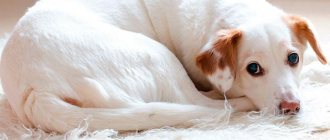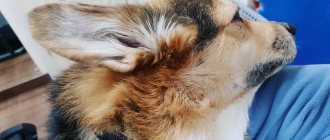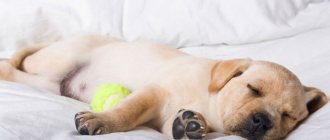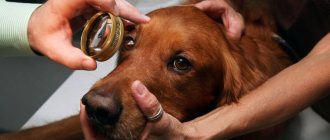Types of Muscle Fibers in Dogs
When planning events to pump up muscles for a dog, owners think about the success of the event, muscle definition and how to spend minimal effort on it. To solve this problem, you need to know how the dog’s body works. After all, ignorance of the basics is the reason for an erroneous training strategy.
Muscle fibers are divided into the following types:
- Red - slow - type I (SMV - slow muscle fibers). They are densely dotted with capillaries, have high aerobic capacity and good endurance, work slowly and get tired slowly, and use “economical” energy sources.
- White - fast - type II (BMW - fast muscle fibers). Their capillary content is moderate, they have high anaerobic capacity and sprinting qualities, they work quickly and get tired quickly, and use fast sources of energy.
Dogs were created to perform a specific function. And different breeds perform different functions. In order to do a job well, the body must match it. For example, hunting dogs are primarily sprinters, they need to quickly catch up to their prey, and naturally they have a predominance of corresponding muscle fibers. And dividing muscle fibers into these types is beneficial, first of all, to the dog’s body. She needs to expend as little energy as possible to perform a specific job as efficiently as possible.
To build muscle mass, both fibers are needed.
Physical stress on dogs. How much, how and why
The importance of physical activity is difficult to overestimate.
This is dog health, strong muscles without excess fat, a well-developed respiratory and cardiovascular system. And healthy longevity is a bonus. In addition, a dog that gets enough physical activity also means the owner’s well-being.
Such a dog behaves calmly at home, appropriate to the situation, and does not rush from corner to corner out of boredom. Does not eat furniture and linoleum from excess energy. She comes home from a walk tired, drinks water and goes to bed. And her sleep is strong and healthy.
Now let's figure out how to load a dog.
Let me make a reservation right away, we will talk about adult and healthy dogs. All of them, of course, are very different, and when doing physical activity, one must take into account age, gender, breed, size, and degree of fitness. Therefore, I can only give general recommendations.
And they will not concern small puppies, sick, old, pregnant or lactating individuals.
The minimum physical activity that should be provided to the dog should be at least 1.5 hours of daily walks. No matter how busy you are, take out this legal minimum 1.5 hours a day and put it down.
You cannot go below this minimum.
It is advisable that this walking time not be spent on a leash at a slow pace. It's better to let the dog fly freely
. When a dog runs on its own, it moves at a pace that is comfortable for itself and very unevenly.
I usually walk my dogs on a leash in difficult places - across the road, past a school or crowds of people. And in a quiet courtyard I let them run around.
A walk in the forest would be ideal in this regard.
The dog runs at a pace that is comfortable for itself, constantly overcoming small obstacles. This is a kind of obstacle course in a light version. Plus exploring new territory.
It is advisable to do this regularly, at least once a week.
If possible, I try to combine at least one walk a day with training. I find a convenient clearing, tie up one dog, and work with the other. Then I swap them.
Obedience acceleration exercises are well suited for physical activity.
- sent to the square, to the target or just to the toy. Calling, fetching, walking around the object. All that needs to be done quickly and energetically.
But walking well on command “nearby” with full concentration also gives a great load.
In addition, I try to give the dog a set of exercises every day
for working out muscles that are little involved during normal running.
For Basta he is like this:
moving backwards - 50 steps
lateral movement - 20 steps in each direction
bow-stand - 10 repetitions
walking backwards onto an object - 5 reps
kneading in the column position - 4 times on each side, 3 approaches
raising the front paws above shoulder level - 5 times on each side
If some exercises are unfamiliar to someone, then you have a great opportunity to learn them with your dog.
But let's not forget that winter is ahead. This means that walking time will be reduced. At the same time, some of the physical exercises can be moved indoors and done at home.
Training on balancing objects is very suitable for this. I will tell you what this is in the next article.
Source
What type is your dog?
To understand which muscle fibers predominate in a particular dog's body, you need to answer questions. Who is your dog: a sprinter or a weightlifter? Athlete or marathon runner?
Marathon runners are sledding breeds that can cover long distances without getting tired. And sprinters are some hunting dogs, for example, greyhounds.
What functions does your dog perform: hunter, sled dog, guard or shepherd?
Sprinters have predominantly fast-twitch muscle fibers. Marathon runners have a predominance of slow-twitch muscle fibers.
You can divide dogs by breed.
In herding, cattle driving, sledding, and primitive breeds, slow muscle fibers predominate.
In hunting, gundog, guard, and sporting dogs, fast-twitch muscle fibers predominate.
In rescue and decorative dogs, the distribution of muscle fibers between fast and slow is approximately 50% to 50%.
While walking, you can offer your dog physical exercise - this will not only build muscles, but also be good for health. If all the muscles are developed, the dog will not have an imbalance in certain parts of the body, and the internal systems will also work well.
Which fibers are better: fast or slow? Correct answer: to maintain the dog’s functions – those that are inherent in the dog’s genetics. To achieve the desired strength, volume and relief - both. In this case, the result will be as beautiful as possible and the dog will be as healthy as possible.
You can start building muscles after the dog’s body is fully formed. And this moment is different for each breed.
Symptoms of otitis in a dog
Symptoms of an ear infection can range from mild to severe. Symptoms are especially pronounced in case of disease progression.
Otitis media causes discomfort to the animal. You can notice it in frequent scratching behind the ears and shaking of the head. Often there is a tilt of the head in a certain direction, especially if inflammation develops in the middle ear cavity.
Symptoms of otitis media in dogs include pain and itching. Upon external examination, you can see redness, foci of inflammation, crusts, hair loss, black or yellow discharge, and smell an unpleasant odor. A sick animal behaves restlessly. Wanting to get rid of discomfort, he may regularly shake his head, rub his ears against furniture and walls. As the condition worsens, the dog loses its balance, may walk in a circle, and begins to hear worse, and, consequently, to respond to commands.
How to train both types of muscle fibers in a dog?
It is necessary to maintain the required intensity for each type of muscle fiber in the dog. To train fast muscle fibers, you need a sharp, strong, intense load. To train slow muscle fibers, static exercises are more suitable, where, for example, you need to hold your paw in one position for at least 30 seconds, etc.
- Perform maximum explosive exercises with short pauses. This point should absolutely not be performed on puppies or older dogs. Principle: weighted total body weight (use of encircling weights), evenly distributed during a sharp start and stop. On day 1, you can use 1 powerful exercise from the following: sprint running with a weighted body weight along a flat trajectory; plyometric jumping training with jumping onto a surface (at a fast pace, the height of the surface is the height of the dog at the withers*2); jerk training up a hill (the start must be from a sitting position, the angle of inclination of the surface is no more than 25 degrees). The rest time between repetitions is no more than 15–20 seconds. The final number of repetitions is no more than 10. The weight should lie only on the back muscles running along the spine, the length of the weight is from the withers to the end of the ribs, the weight at the initial stage is 10% on each side (20% in total), you can gradually increase it to 20% per side (total 40%). You should not run on asphalt, only on the ground, so as not to harm the dog’s joints. A warm-up is required first.
- Biomechanical principle. Using more advantageous exercises that involve the maximum number of muscles at the same time. Unstable single-level surface (for example, a sofa mattress). Use of obstacles. You can use 1 winning exercise in 1 day from the following: sit / lie / stand / lie / sit / stand obstacle course (at home you can make cavaletti from mop sticks placed on books at the same level) multi-speed training (step - slow trot – walk – fast trot, etc., with a time limit – no more than 10 minutes).
- Sets of exercises. The principle is supersets for a specific muscle group, consisting of a speed exercise, a strength exercise, an isolated exercise, and an exercise with your own body weight. On day 1, you can use 1 of the supersets: muscles of the neck, back and body, muscles of the hind limbs, muscles of the front limbs and chest. Supersets are done at a very fast pace in order to maximally engage the dog’s muscular system. For example, when it comes to the muscles of the hind limbs, exercises could include: jumping or skipping - no higher than the dog's elbow, lots of low jumping at a fast pace walking or running with weights sit-stand exercises with the hind legs elevated surfaces - for example, on a step, the “Sit - stand - lie” complex at a rather slow pace.
- Negative phase. Principle: fast contraction, slow muscle relaxation. For example, a dog's front paws are on a raised surface, and he follows the commands "Sit - Stand" without removing his front paws from the raised surface. She should get up quickly, and lower herself onto her hind legs as slowly as possible, and under no circumstances fall into the “sitting” position. These exercises can be done every day.
- Voltage time. Principle: tension the dog’s muscles for as long as possible (up to 30 seconds). For example, a dog reaches for a treat for a long time, tensing its muscles as much as possible (standing on tiptoe). These exercises can be done every day.
For puppies and adolescents, you can use methods 5, 4, 3 (without strength and isolation exercises), 2 (without steeplechase).
Formed young healthy dogs can receive all types of exercise.
For older, healthy dogs, all methods are suitable except maximally explosive exercises with short pauses.
There are 5 methods of pumping up muscles in a dog
who have passed performance tests. These methods use both types of muscle fibers.
Training your dog to develop muscle mass
A powerful dog, flexing its muscles, proudly walking next to its owner, involuntarily evokes respect and attracts the eye. When you see a fully grown puppy, clumsily moving his paws, growing, as they say, a week in height, a week in length, it’s hard to believe that he will eventually grow into a dog as powerful as his parents.
When training a dog
The type of constitution should also be taken into account. You can work up a sweat with a dog, but instead of expanding the chest and increasing the relief, it will only “dry.” Before starting training, you should determine the ultimate goal of these exercises. There are few options: build muscle mass and “develop” the dog, or increase the dog’s endurance and strength. At first glance, these two goals can be combined and work in two directions at once. But during the course of training, you will understand that endurance training is slightly different from other types of training, since it is general strengthening and tonic.
Physical exercises for dogs.
You choose exercises for your dog yourself, depending on the dog’s temperament and its inclinations. Some people like to run, some like to carry weights, some like to swim, etc. Any load, no matter what you choose, must be increased gradually, because... Excessive exercise is fraught with diseases of the joints and muscles. Do not start or end exercises abruptly; there must be a warm-up and cool-down. It is also necessary to provide the dog with access to water, especially in the summer, to avoid dehydration.
Running load.
Jogging, running behind a bicycle, fetching an object, fetching on a slide. It is advisable to give the dog running exercise on an unpaved surface (dirt, rubber tracks or fine gravel). Walking on gravel is especially important for dogs with wide toes; pebbles get caught between the toes, which causes the dog to “collect” their paws. For small puppies, it is advisable to start with a walk, then move to a fast walk and only then to a jog. But classes will not be effective if you drag the puppy along with you on a leash; he must do everything of his own free will, and not under coercion. Also gradually increase the walking time. Excessive stress in young dogs can cause bones to bend.
A dog running after a bicycle.
Running behind a bicycle involves a fairly long load, so make sure your dog is ready for it. The speed of movement should be such that the dog can only trot; it can go into a gallop very rarely and for a short time. Running behind a bicycle contributes to the formation of beautiful posture and muscles in a dog, and is often used in preparation for exhibitions. After such a load, the dog’s show “stance” is more natural, beautiful, and what’s most interesting is that the dog gets into it on its own.
Retrieving as a physical activity for dogs.
Importation
(tray) of an object - when performed correctly, the dog performs the exercise in a gallop or gallop, so the duration of the exercise should be limited, or the dog should already be very well developed physically. Otherwise, the dog will begin to get tired and will fetch the object at a trot, i.e. You yourself can ruin a good, quick tray of an item. If your dog already performs this skill slowly (i.e. trotting), then you can practice for a long time until the dog gets tired of it. Going to a step or refusing to execute a command will mean overloading.
Importation on a slide
- the same as the previous one, but on a sloping surface. This type of exercise is not recommended for dogs under one year of age, because... running downhill has a bad effect on joints and tendons that have not yet become stronger. It is necessary to start classes first on gentle small hills, gradually increasing the length and steepness of the climb. For athletic and well-trained dogs, the angle of inclination can be increased to 50-60 degrees.
An exercise for a dog is climbing stairs.
Walking up the stairs
. Prolonged movement down the stairs, especially for puppies and young dogs, is strictly prohibited, and for others it is undesirable. But the upward movement is of great importance for the development of the dog, not only for the development of muscle mass, but also for the functioning of the vestibular apparatus. Like any other load, walking up stairs should be increased gradually.
Swimming.
This type of exercise is recommended for almost all breeds of dogs of any age. It has practically no contraindications, except perhaps the dog’s fear of water. The only exercise used in rehabilitation treatment, especially after joint injuries, limb fractures, etc. Swimming is indispensable in the summer, when high air temperatures do not allow the use of other types of exercise, in order to avoid overheating of the dog.
Overcoming obstacles.
Low obstacles are used for training. When overcoming obstacles, different muscle groups are involved than when running, so they are an additional exercise to running. High obstacles are overcome extremely rarely in order to reduce the load on the joints when jumping from the apparatus. Long-term overcoming of obstacles is undesirable for large and heavy dogs; for some breeds it is generally prohibited.
Towing.
This type of exercise is contraindicated in dogs under 1 year old, and in some breeds up to 1.5 years old, because The dog's skeleton is not yet fully formed. This exercise not only develops the paw muscles, but also trains the muscles of the back, chest and neck. When towing, a special harness is used, the ring fastening of which is located at the base of the tail to avoid lateral loads on the spine. You can tow: tires, carts, sleds, skiers. Increasing the speed and severity of the objects towed should be consistent with your dog's physical condition.
Carrying heavy loads with a dog.
This type of training is contraindicated in dogs under 1 year old, and in some breeds up to 1.5 years old, because
The dog's skeleton is not yet fully formed. Everyone uses a weighted harness differently, many hang it on their dog around the clock, some only during training. The most correct option would be to put a load on the dog in the form of a harness after short runs, when the dog’s muscles are warmed up and the airways are working smoothly. Otherwise, you can simply tear the dog’s tendons, or drive him to exhaustion. First of all, the load is applied to the side muscles of the dog, then added to the chest and then only the neck (more on this later).
The load should be distributed evenly over the part of the body that is being trained; in this case, if the dog is just starting to be trained, a uniform load should be placed on the lateral muscles. It is better to start with 50 grams, but if you are impatient to get instant results, you can take loads of 100 grams, but no more. Gradually, the weight of the cargo will naturally increase. Those. on the harness should be evenly distributed from 50 grams to 100 grams of weights, on one side 50 and on the other 50, in total we get 100, on the one hand, I remind you of a maximum of 100 grams. This is for dogs who are just starting training.
You can further increase the load up to 4 kilograms of the total weight of the harness (including the load on the chest, lateral muscles and neck. The first training will look something like this: first walk (to ease the dog) for about 20 minutes, then run for about 10 minutes at a trot, then you can give about 10–20 jumps, then put on a harness and you can walk further, jumping with a harness can only be done if it is fastened tightly and does not dangle, otherwise there is simply a strong kickback with a lot of weight, I think everyone has heard about resonance. A walk in a harness should first be about 30 minutes, then a regular walk with jumping and running, without a harness, and so a walk in a harness should be added to the day by 5 minutes.The weight increases every week by 100 grams of total weight.
You should train 5 through two, i.e. You work with the dog for 5 days and give it rest for 2 days, while simply increasing the walk by 20-30 minutes without jumping and running, to unload. The main thing is not to overdo it with the weight and time of the walk; do not rush, otherwise you can only harm the dog.
An article about puppy training broken down by age.
when using materials
link to resource wolcha.ru
required
News edited by: maugli
— 12-11-2019, 01:32
Additional equipment for pumping up your dog's muscles
In order to quickly pump up your dog’s muscles, you will need additional equipment:
- unstable surface (at home this could be an air mattress - the main thing is that it can withstand the dog’s claws)
- stable elevations (curb, step, bench, books, etc.)
- encircling weights
- bandages, cavaletti
- tape expanders
- stopwatch
- necessary auxiliary equipment.
Decide on the purpose of the lesson. Before you start pumping up your dog's muscles, you need to answer the question of what result you want.
If you want to achieve muscle hypertrophy, you cannot do without additional devices. To create a beautiful, sculpted body, you can do without some devices, replacing them with other exercises. If the goal is to maintain muscle health and function, additional devices are not needed.
Rheumatic myositis
This type of myositis has an infectious-allergic etiology; during the course of the disease, neurodystrophic processes occur in the connective tissues of the muscles. It can occur in both acute and chronic forms.
The exact causes of rheumatic myositis have not yet been identified, but there are signs of an allergic and infectious (against the background of hemolytic streptococci) nature.
Among the factors predisposing to the development of the disease are the following:
- frequent and prolonged colds;
- sudden hypothermia of the body (swimming in ponds, exposure to rain, often dogs become hypothermic when they run away from their owners and wander for a long time, walking after taking a bath);
- tendency to allergic reactions;
- advanced age;
- obesity;
- weak immune system.
Most often, working dogs of hunting and herding breeds suffer from rheumatic myositis. The disease is always accompanied by pain in the damaged muscles. Dogs suffering from myositis try to move less, whine and yelp when touched. It is difficult for pets to rise from a lying position; when walking, it is noticeable that they are tense.
It is difficult for your pet to defecate; he may moan at this time, and sometimes he cannot go to the toilet at all. If the lesion affects only some muscle groups, then the signs of myositis are less pronounced.
The muscles of the lumbar region and back are most often affected by the rheumatic type of disease. Any, even the most insignificant movement, in this case, is extremely painful, and the animal appears noticeably hunched over.
When rheumatoid damage spreads, the cervical and occipital regions are involved. In such a situation, it is very difficult for the dog to eat food, since due to the pain syndrome, it can neither raise nor lower its head. And, in addition, rheumatism can also affect the muscles responsible for chewing processes, then the pet will not be able to eat at all. When the muscles of the limbs are damaged, the animal begins to limp.
When palpating the location of the disease, you can feel muscle tension and swelling; at this moment the pet feels severe pain.
With an exacerbation of rheumatic myositis, a sharp increase in temperature can be observed; in severe cases, pain can move from one muscle group to another. Against the background of a chronic illness, muscle atrophy occurs.
Treatment of the disease is complex:
- If the dog is kept on a chain or in an enclosure, it is necessary to place it in a warm room.
- To eliminate the pathogenic B-hemolytic bacterium streptococcus, antibiotic therapy is used intramuscularly (Penicillin, Bicillin-3, etc.). For a positive effect, a loading dose is calculated.
- For internal use, drugs with a specific antirheumatic effect are prescribed - Brufen, Butadione, sodium salicylic acid.
- To relieve pain, Analgin injections are given (subcutaneously or intramuscularly).
- An effective procedure in this case is blood transfusion (the blood must be stabilized with sodium salicylate);
- Therapy is often supplemented with glucocorticoids.
The following procedures also give positive results: UHF, light irradiation, therapeutic massage. It is useful to rub the affected muscles with irritating liniment. For the same purposes, you can prepare a special mixture of bleached and camphor oil, salicylic acid and methyl ester. The use of this method followed by wrapping provides effective pain relief.
Safety precautions when pumping up a dog's muscles
- Preliminary check of the dog’s health (pulse, condition, breathing rate, joint mobility).
- The right incentive.
- Compliance with the rules of thermoregulation.
- Compliance with drinking regime. The dog can drink during training and immediately after, but not much (a couple of sips).
- Strong nervous system of the owner. If something doesn’t work out today, it will work out another time. Don't take it out on the dog, take care of it.
Remember that safety is paramount!
Prevention of otitis in dogs
The easiest way to treat diseases, as you know, is prevention
Even cleaning the ears weekly will do your dog's health a huge favor. This is especially important if she has long, floppy ears that contain a lot of hair, or suffers from another condition such as seasonal allergies. For preventive purposes, you can carry out regular grooming of this area.
Your veterinarian may recommend an ear cleaner that can be used on your pet every week to keep the ears clean and free of potential debris and bacteria. This process may seem traumatic, but veterinarians strongly recommend not to abandon this procedure, repeating it weekly.
The more often this procedure is performed and the earlier it is started, the easier it will be for the animal to get used to it.
If your dog is prone to developing ear infections or other illnesses, it is important not only to see a doctor after the onset of illness, but also to undergo regular preventive examinations
Some individuals are prone to otitis externa due to the unique anatomy of their ears. Swelling and inflammation often causes a noticeable narrowing of the ear canal, which helps retain moisture and secretions, which create ideal conditions for infection to develop.
Proper examination with a thorough diagnosis is vital to developing the most effective treatment plan for affected animals
All patients with otitis media undergo anti-inflammatory steroid therapy and proper ear cleaning, the latter of which is necessary before starting antibacterial or antifungal therapy. If too much damage has been done to the outer ear, surgery can restore comfort and ensure a full recovery.
Key points
- Aging dogs may lose strength in their hind legs and the ability to know exactly where their legs are.
- Age-appropriate exercise can improve a senior dog's quality of life.
- Strength and flexibility exercises can be done at home.
- exercise
- aged people
- crafts
“Use it or lose it,” the saying goes, and this applies to dogs and people alike.
This is why regular exercise becomes more important every year and is especially effective for older dogs. “Many older dogs often lose strength in their hind legs, as well as proprioception—essentially the ability to know where their legs are,” says Dr. Barbara Butler, DVM, a certified canine rehabilitation therapist (CCRT) and certified veterinary acupuncturist. “It is important for owners to provide exercises at home that are appropriate for their dog’s age and skills. This can have a big impact on an older dog's quality of life physically and in terms of mental acuity."
Swimming, leash walks and gentle games of hide and seek are all great ways to stay fit. But there are also many strength and flexibility movements—canine calisthenics—that you can do in the comfort of your own home. The three simple exercises presented here will work problem areas for many older adults.
Your first step is to talk to your veterinarian to make sure your exercise plan is appropriate for your dog's current fitness level. Then grab your treats and your favorite oldie and get started. You can do these exercises every other day. Aim for one to three sets of two to five repetitions of each exercise. This may take some learning and practice over time. Warm up and cool down with a five minute leash walk before and after.
Faster, slower, stop.
Faster, Slower, Stop is the high-speed version of Red Light, Green Light. As you exercise, your dog will learn the commands to speed up and slow down.
To start playing, just tell your dog “Faster!” and start walking faster, or start running. You can also use the "Faster!" command. jog for now, but don't overdo it. Then say “Slow down” and reduce your speed until you say “Stop.”
Your pet will have to concentrate on you in order to understand how fast he needs to go. You can use treats for following commands.
Benefits of play: Again, it gets the dog involved as it needs to figure out what's coming next and keep its attention on its owner.
How do you walk with your pet? Do you use games while walking? Share your ideas in the comments!











